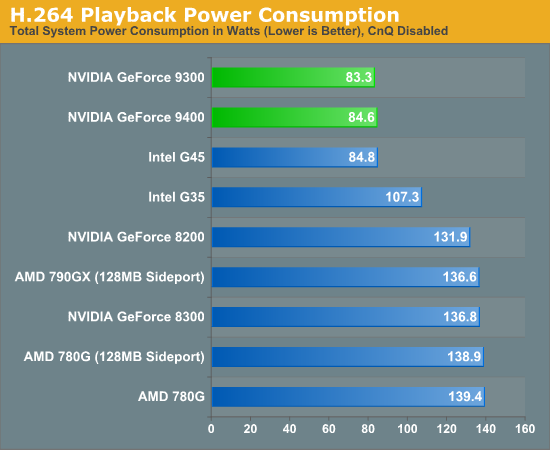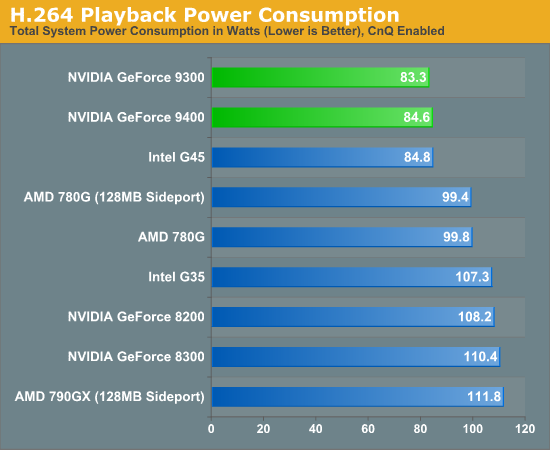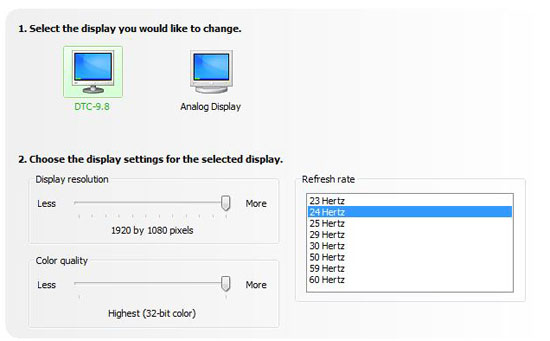The IGP Chronicles Part 3: NVIDIA's GeForce 9300
by Anand Lal Shimpi & Gary Key on October 15, 2008 12:00 AM EST- Posted in
- Motherboards
Blu-ray Power Consumption
Since we're dealing with an Intel platform from NVIDIA, the Cool'n'Quiet issues we mentioned in our previous article don't apply here. You simply get the best combination of low CPU utilization and very low power consumption when watching HD content:


So far so good; we don't have any HDMI incompatibilities, no repeater issues to report, the GeForce 9300 just worked in all of our home theater setups. But how about the more niche features?
8-channel LPCM support comes natively with the GeForce 9300 and like on the Radeon HD 4xxx series, it just works. NVIDIA's platform drivers include an HDMI audio driver that, once installed, allows you to configure your audio output as 2, 6 or 8 channels. Of course bitstreaming both Dolby Digital and DTS audio is supported. Unfortunately, as we've mentioned before, there is no support for bitstreaming Dolby TrueHD or DTS-HD MA; you'll need to wait until sometime next year before you get full support there.
As we mentioned in our last article, proper 24Hz refresh rate support is particularly useful for playing back 24 fps content (which happens to be most movie content). Intel offers no support for 24Hz/24fps playback, AMD's implementation is a bit flaky, but NVIDIA's works flawlessly (at least with our test subjects). When connected to a display that supports a 24Hz input signal the option appears in the driver; just select it and you're good to go. The result is silky smooth playback of video content and it's nice.

Short of TrueHD/DTS-HD MA support, NVIDIA's GeForce 9300 is the perfect HTPC chipset. The NVIDIA control panel even offers more post processing customization options than both AMD and Intel, although we're thankful that NVIDIA disables all of the features by default. Honestly the only other complaint we have is that we need to have a monitor hooked up to the system to first get it installed in our home theater setup; once properly configured it worked flawlessly with our Integra DTC-9.8 pre-processor and JVC DLA-RS2 projector setup. There is still need for improvement on the software side to enable users to build a computer and simply plug it into a HT setup without a monitor and have it work.
Good job NVIDIA, here's your crown. (Care for a service plan with that?)










47 Comments
View All Comments
cghebert - Wednesday, October 15, 2008 - link
Hey guys,Great to see the articles are up. A couple of quick questions and a comment.
Could you mention clearly what nvidia driver versions (both graphics and HDMI) you used for the tests?
Also, you seem to hint that 5.1 audio is an option with this newest driver set from nvidia. Is this indeed the case?
Also, to echo the comments of some others, it would be nice to see the blu ray playback numbers with cheaper cpus. I have seen the Athlon X2 BE (2.3 ghz) going for less than $40, and even a 3 ghz X2 for $75 or so, which would certainly make buying a cheap discrete graphics card a viable option cost-wise.
nvmarino - Wednesday, October 15, 2008 - link
>>Unfortunately, as we've mentioned before, there is no support for bitstreaming Dolby TrueHD or DTS-HD MA; you'll need to wait until sometime next year before you get full support there.Hmm - does that mean the hardware is there in THIS chipset but we nned to wait for driver/bios updates!?!?!?!? Or are we talking about a new chipset?
Anand Lal Shimpi - Wednesday, October 15, 2008 - link
Sorry for the confusion, absolutely none of the current chipsets (G45, 780G, GF8200, GF9300) support or will support bitstreaming TrueHD/DTS-HD MA. Next year we will see the first GPUs with actual support for this.8-channel LPCM is the best you'll get for now.
-A
3DoubleD - Friday, October 17, 2008 - link
Isn't LPCM the best you can get anyway? Your Blu-ray decoder (Eg. PowerDVD, standalone Blu-ray player) decodes the audio stream (the best available) and sends that audio to your stereo via PCM. Some Blu-rays even have the LPCM stream raw on the disc. Why would you ever want/care about TrueHD/DTS-HD MA streaming when you are already getting perfect, lossless 7.1 audio to your speakers?Source: http://www.highdefdigest.com/news/show/1064">http://www.highdefdigest.com/news/show/1064
nvmarino - Wednesday, October 15, 2008 - link
Hybrd power was one of the more compelling features of this chipset for HTPC use - I want my box sipping as little juice as possible untile game time. Unfortunately, all the reviews I've read so far and this Nvidia page:http://www.nvidia.com/object/hybrid_sli_desktop.ht...">http://www.nvidia.com/object/hybrid_sli_desktop.ht...
seem to indicate Hybrid Power is NOT a feature of the new chipset. I read the comment earlier about it being up to board manufacturers to implement but the page linked above seems to indicate the chipset itself lacks support. Can you guys please confirm?
sascham - Wednesday, October 15, 2008 - link
I've been holding off buying my new rig for 3 months just for this feature. I'm on 100% solar power and although I can still run my current rig that draws more power than a newer one will, any savings I can make are worthwhile (and give me more scope elsewhere).All the reading I did months ago suggested this chipset would deliver Hybrid Power with Intel CPU. What's the official word on this? If, as the nvidia page linked suggests, this chipset does not deliver this, what's next? When do we get it?
Mr Roboto - Wednesday, October 15, 2008 - link
I'm not the brightest crayon on the box when it comes to tech but couldn't a company just solder on a decent chip and forget this whole IGP nonsense? Like take an Nvidia 9500 or 9600 chip and solder it right on to the board along with 128MB DDR RAM. You'd have you're reasonable gaming performance without suffering through the 9300 which looks to be nothing extraordinary. Couldn't they cool it with standard HSF?Seems to be a lot of effort for little reward.
sprockkets - Wednesday, October 15, 2008 - link
There would be little room for it, unless you gave up say two slots. Chaintech did this years ago, cool motherboard, but ran very hot. Suffice to say, no one bothers with it anymore. You might as well just add the memory like side port but a seperate chipset and graphics chip? Only works well in laptops.Calin - Thursday, October 16, 2008 - link
You're not saving so much money over a discrete video card (you still need everything a video card have), and you can't "upgrade" (yes, you can add another video card and disable the onboard one, but you can't have your cake and eat it too).3DoubleD - Wednesday, October 15, 2008 - link
Sounds great. Now all we need is a follow-up of the HD 4xxx article as well as confirmation about whether or not these Nvidia issues are solved or will be solved shortly.I'm really enjoying these HTPC based articles and hope you continue them. Now that the HDMI + 7.1 audio issue has finally been addressed I think it would be helpful to start looking into the software end of HTPCs, such as a Media Center software review (what programs that work well, include blu-ray playback, OTA support, network features, ect).
There are tempting systems such as the FuzeBox Media Server http://www.velocitymicro.com/wizard.php?iid=167">http://www.velocitymicro.com/wizard.php?iid=167 , which includes a seamless interface for Cablecard capture, blu-ray playback, multizone playback, expandable storage, network backups). The interface locks the user from exiting the media center interface, but provides a reliable, seamless, and feature rich experience that I have yet to experience with other media centers. The enthusiast looks at the price tag for such a machine and says, I can build that for half, except that the media center software isn't there. Help us enthusiast achieve that seamless experience without having to empty our pockets for pre-assembled box!
Thanks